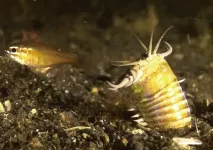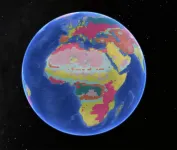INFORMATION:
Giant predatory worms roamed the seafloor until 5.3 million years ago
The seafloor was inhabited by giant predatory worms until 5.3 million years ago
2021-02-18
(Press-News.org) An international study in which the University of Granada participated--recently published in the journal Scientific Reports--has identified a new fossil record of these mysterious animals in the northeast of Taiwan (China), in marine sediments from the Miocene Age (between 23 and 5.3 million years ago)
These organisms, similar to today's Bobbit worm (Eunice aphroditois), were approximately 2 m long and 3 cm in diameter and lived in burrows
An international study in which the University of Granada (UGR) participated (recently published in the prestigious journal Scientific Reports) has revealed that the seafloor was inhabited by giant predatory worms during the Miocene Age (23-5.3 million years ago).
The scientists identified a new fossil record (indirect remains of animal activity such as, for instance, dinosaur tracks, fossilised droppings, insect nests, or burrows) linked to these mysterious animals, which are possible predecessors of today's Bobbit worm (Eunice aphroditois). Based on the reconstruction of giant burrows observed in Miocene-age marine sediments from northeast Taiwan (China), the researchers concluded that these trace fossils may have colonised the seafloor of the Eurasian continent about 20 million years ago.
Olmo Míguez Salas of the UGR's Department of Stratigraphy and Palaeontology (Ichnology and Palaeoenvironment Research Group) participated in the study, which was conducted as part of a project funded by the Taiwanese Ministry of Science and Technology (MOST, 2018) of which the researcher was a beneficiary.
Míguez Salas and the other researchers reconstructed this new fossil record, which they have named Pennichnus formosae. It consists of an L-shaped burrow, approximately 2 m long and 2-3 cm in diameter, indicating the size and shape of the organism-- Eunice aphroditois--that made the structure.
Bobbit worms hide in long, narrow burrows in the seafloor and propel themselves upward to grab prey with their strong jaws. The authors suggest that the motion involved in capturing their prey and retreating into their burrow to digest it caused various alterations to the structure of the burrows. These alterations are conserved in the Pennichnus formosae and are indicative of the deformation of the sediment surrounding the upper part of the burrow. Detailed analysis revealed a high concentration of iron in this upper section, which may, the researchers believe, indicate that the worms continuously rebuilt the opening to the burrow by secreting a type of mucus to strengthen the wall, because bacteria that feed on this mucus create environments rich in iron.
Although marine invertebrates have existed since the early Paleozoic, their bodies primarily comprise soft tissue and are therefore rarely preserved. The fossil record discovered in this study is believed to be the earliest known specimen of a subsurface-dwelling ambush predator.
Olmo Míguez Salas notes that this finding "provides a rare view of the behaviour of these creatures under the seafloor and also highlights the value of studying fossil records to understand the behaviour of organisms from the past."
ELSE PRESS RELEASES FROM THIS DATE:
A study with 1,600 dogs: More than 20 gene loci associated with canine hip dysplasia
2021-02-18
Hip dysplasia is a developmental disorder common in most dog breeds, and its onset is affected by both hereditary and environmental factors.
Prior studies have identified dozens of genetic loci associated with hip dysplasia in various breeds. The relevance of the loci to disease susceptibility remains an open question. The previously identified loci were reinvestigated at the University of Helsinki, Finland, using a large independent cohort of 1,600 dogs representing ten breeds.
The individual genetic variants at the target loci were determined from blood samples. The standardized ...
Older adults and antibiotics: Study shows healthy attitudes but unhealthy practices
2021-02-18
While most adults over 50 understand that overuse of antibiotics is a problem, and say they're cautious about taking the drugs, a sizable minority have used antibiotics for something other than their original purpose, and appear to think the drugs could help treat colds, which are caused by viruses not bacteria.
These findings, contained in a new paper in Infection Control and Hospital Epidemiology, come from a national poll of people between the ages of 50 and 80 carried out as part of the National Poll on Healthy Aging.
The authors, from the University of ...
LHC/ATLAS: A unique observation of particle pair creation in photon-photon collisions
2021-02-18
Cracow, 18 February 2021
Creation of matter in an interaction of two photons belongs to a class of very rare phenomena. From the data of the ATLAS experiment at the LHC, collected with the new AFP proton detectors at the highest energies available to-date, a more accurate - and more interesting - picture of the phenomena occurring during photon collisions is emerging.
If you point a glowing flashlight towards another one, you do not expect any spectacular phenomena. The photons emitted by both flashlights simply pass by each other. However, in certain collisions involving high-energy protons the situation is different. The ...
Shale gas development in PA increases exposure of some to air pollutants
2021-02-18
Air pollution levels may have exceeded air quality standards during the development of some Marcellus Shale natural gas wells in Pennsylvania, potentially impacting more than 36,000 people in one year alone during the drilling boom, according to Penn State scientists.
"The construction and drilling of these wells are a relatively short-term thing, and assessment of the impact on air quality is something that often falls through the cracks," said Jeremy Gernand, associate professor of industrial health and safety at Penn State. "But there are thousands and thousands of wells drilled depending on the year, and we wanted to see what the impact would be if we added it all up."
More than 20,000 unconventional Marcellus Shale gas wells have been drilled ...
The distribution of vertebrate animals redefines temperate and cold climate regions
2021-02-18
The distribution of vegetation is routinely used to classify climate regions worldwide, yet whether these regions are relevant to other organisms is unknown. Umeå researchers have established climate regions based on vertebrate species' distributions in a new study published in eLife. They found that while high-energy climate regions are similar across vertebrate and plant groups, there are large differences in temperate and cold climates.
Climate determines how life organises across the world. Understanding which climatic conditions drive important changes in ecosystems is crucial to understanding and predicting how life functions and evolves.
Human well-being critically ...
Pandemic got you down? A little nature could help
2021-02-18
Having trouble coping with COVID?
Go take a hike. Literally.
Researchers have long been aware of the positive impact of a connection with nature on psychological health and, according to a new study published in the journal Personality and Individual Differences, the pandemic hasn't decreased the power of nature to improve mental well-being.
"Thinking about the natural world in an interconnected and harmonious way corresponds to improved psychological health, no matter where you are," says Brian W. Haas, the lead author of the new study and an associate professor in the Behavioral and Brain Sciences Program at the University of Georgia.
Haas and his collaborators - Fumiko Hoeft, a professor of psychological sciences at UConn ...
Investigating the wave properties of matter with vibrating molecules
2021-02-18
Almost 100 years ago, a revolutionary discovery was made in the field of physics: microscopic matter exhibits wave properties. Over the decades, more and more precise experiments have been used to measure the wave properties of electrons in particular. These experiments were mostly based on spectroscopic analysis of the hydrogen atom and they enabled verifying the accuracy of the quantum theory of the electron.
For heavy elementary particles - for example protons - and nuclides (atomic nuclei), it is difficult to measure their wave properties accurately. In principle, however, these properties can be seen everywhere. In molecules, the wave properties ...
Social tool tracks brand reputation in real time and over the long term
2021-02-18
An international team of researchers has developed a framework for assessing brand reputation in real time and over time, and built a tool for implementing the framework. In a proof of concept demonstration looking at leading brands, the researchers found that changes in a given brand's stock shares reflected real-time changes in the brand's reputation.
"We've developed something we call the Brand Reputation Tracker that mines social media text on Twitter and uses 11 different measures to give us an in-depth understanding of how users feel about individual brands," says Bill Rand, co-lead author of the paper and an associate professor of marketing in North Carolina State University's Poole College of Management.
The Brand Reputation Tracker ...
Human brain taps into visual cues when lacking a sense of touch - study
2021-02-18
Evidence that a sense of our physical selves can develop even without the sense of touch has been uncovered in a new study by researchers in the UK and the United States.
The research shows that if someone loses their sense of touch and 'proprioception' - their sense of body position - as an adult, they may learn compensatory skills using visual cues and conscious thought, or reasoning, to move their bodies.
Someone who has never had a sense of touch or proprioception, however, can find faster, unconscious ways of processing visual cues to move and orient themselves.
A team at the University of Birmingham collaborated with researchers at Bournemouth University and the University of Chicago on the study, ...
Human impact on solar radiation levels for decades
2021-02-18
In the late 1980s and 1990s, researchers at ETH Zurich discovered the first indications that the amount of sunlight reaching the Earth's surface had been steadily declining since the 1950s. The phenomenon was known as "global dimming". However, a reversal in this trend became discernible in the late 1980s. The atmosphere brightened again at many locations and surface solar radiation increased.
"In previous studies, we showed that the amount of sunlight that reaches the Earth's surface is not constant over many decades but instead varies substantially - a phenomenon known as global dimming and brightening," ...
LAST 30 PRESS RELEASES:
Early relapse predicts poor outcomes in aggressive blood cancer
American College of Lifestyle Medicine applauds two CMS models aligned with lifestyle medicine practice and reimbursement
Clinical trial finds cannabis use not a barrier to quitting nicotine vaping
Supplemental nutrition assistance program policies and food insecurity
Switching immune cells to “night mode” could limit damage after a heart attack, study suggests
URI-based Global RIghts Project report spotlights continued troubling trends in worldwide inhumane treatment
Neutrophils are less aggressive at night, explaining why nighttime heart attacks cause less damage than daytime events
Menopausal hormone therapy may not pose breast cancer risk for women with BRCA mutations
Mobile health tool may improve quality of life for adolescent and young adult breast cancer survivors
Acupuncture may help improve perceived breast cancer-related cognitive difficulties over usual care
Nerve block may reduce opioid use in infants undergoing cleft palate surgery
CRISPR primes goldenberry for fruit bowl fame
Mass General Brigham announces new AI company to accelerate clinical trial screening and patient recruitment
Fat tissue around the heart may contribute to greater heart injury after a heart attack
Jeonbuk National University researcher proposes a proposing a two-stage decision-making framework of lithium governance in Latin America
Chromatin accessibility maps reveal how stem cells drive myelodysplastic progression
Cartilaginous cells regulate growth and blood vessel formation in bones
Plant hormone allows lifelong control of proteins in living animal for first time
Swedish freshwater bacteria give new insights into bacterial evolution
Global measures consistently underestimate food insecurity; one in five who suffer from hunger may go uncounted
Hidden patterns of isolation and segregation found in all American cities
FDA drug trials exclude a widening slice of Americans
Sea reptile’s tooth shows that mosasaurs could live in freshwater
Pure bred: New stem cell medium only has canine components
Largest study of its kind highlights benefits – and risks – of plant-based diets in children
Synergistic effects of single-crystal HfB2 nanorods: Simultaneous enhancement of mechanical properties and ablation resistance
Mysterious X-ray variability of the strongly magnetized neutron star NGC 7793 P13
The key to increasing patients’ advance care medical planning may be automatic patient outreach
Palaeontology: Ancient tooth suggests ocean predator could hunt in rivers
Polar bears may be adapting to survive warmer climates, says study
[Press-News.org] Giant predatory worms roamed the seafloor until 5.3 million years agoThe seafloor was inhabited by giant predatory worms until 5.3 million years ago






